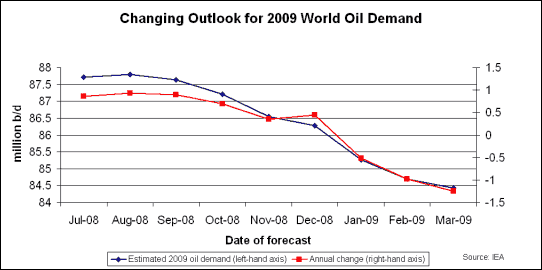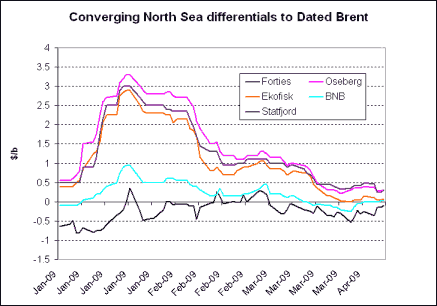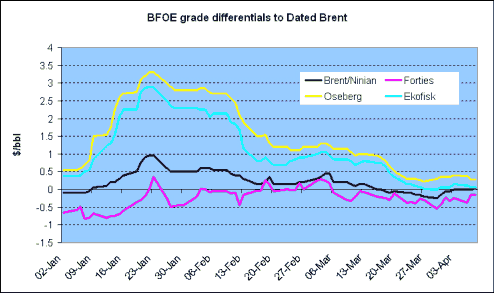The large drop-off in global oil demand - both predicted and actual - has
forced a major change on the way oil is traded, as companies grapple with a
financial structure not seen in decades. \
Changing outlook for 2009 world oil demand (million b/d)

The International Energy Agency's revised demand figures in September 2008
gave oil producers further cause for concern as they tried to balance output
and selling their oil at a price that could ensure some kind of profit.
The deepening contango has led to a shift in trading and shipping
strategies that has actually supported prices for certain grades of crude
oil ...
Another sector also seeing potentially crippling falls in value is the
freight market, where ship owners have struggled to come to terms with the
fall in demand, leaving large sections of the global fleet mothballed off
key hubs such as Singapore.
Some succor has come, however, from the store now/sell later structure that
has pervaded the market in a more marked fashion since the global economic
climate took a major downturn in 2009.
The deepening contango has led to a shift in trading and shipping strategies
that has actually supported prices for certain grades of crude oil in what
is a fundamentally weak market environment.
Contango is nothing new in the oil markets.
The situation where prices are higher further down the line has been the
norm for the last five years or so, as demand for actual physical oil has
not created too much of a scramble for barrels.
But the major change seen since the back end of 2008 has been the depth of
the contango, with front-month crude futures falling well below levels of
the subsequent months.
Twinned with cheap freight, this has created a trend in floating storage, in
which traders capitalize on low waterborne storage costs and sell the oil.
The first major rash of chartering very large crude carriers (VLCCs)
began in October, when majors Shell and BP started putting crude they owned.
At the time, front-month futures were around $2.50/b cheaper than
second-month contracts, which, effectively meant that this physical position
could be rolled into the next month if the cost of storage amounted to less
than this spread.
Since then, the names of these huge vessels have become well known in the
trading community, as players try to predict when they will see oil
discharged from ships such as Leander, Eliza and Oliva.
The names of these vessels might be easier on the ear than their hulking
frames are on the eye, as residents of the UK see their enormous frames
moored off the coast, awaiting orders.
The effect on the freight market has occasionally been supportive, as when
the front spread reaches the kind of levels where storage makes sense,
enquiries for vessels rise and a potentially lucrative time charter could
soon be on the books for some.
But the real beneficiary of the contango storage play has been plentiful
North Sea grade Forties, which has seen cyclical support in line with the
widening and deepening front spread while other crudes have slumped.
Converging North Sea differentials to Dated Brent ($/b)

Traders in the North Sea have said for most of 2009 that there is little
refinery demand, especially during the traditional maintenance periods of
March and April.
As a result, prices for all the crude grades in the area have fallen
dramatically.
But one grade in the North Sea has kept its value, mostly due to the fact
that it is the grade of choice for storage due to its large volume of
650,000 b/d and its close relationship to the benchmark Dated Brent/BFOE.
BFOE grade differentials to Dated Brent ($/bbl)

Forties was once the darling of the gasoline industry, its low sulfur and
low density fitting well in a refinery keen to make light, sweet products.
Since 2007, however, when the huge and sulfurous Buzzard field was connected
to its system, output has risen but values have fallen, as the blend has
taken on new properties and buying profile.
Now the grade is packed with heavy fuel oil and light naphtha and does not
travel as often to the US as it once did.
When more refinery buying returns every now and then and the contango
weakens to reflect stronger buying at the front of the curve, some of the
oil stored on the seas of Northwest Europe is sold, containing the upside
for crude prices.
As there is over a cargo a day of Forties available and logistics at its
base of Hound Point in Scotland are sufficiently easy for loading a VLCC,
all it takes is for one buyer to hold three consecutive stems and a vessel
for floating storage to become a reality.
However, getting all three cargoes lined up in a row can take some
aggressive bidding to make it worth a seller's while, leaving the grade's
price occasionally pushed around between generally weak refinery demand and
strong buying interest on very specific cargoes.
As a result of this buying, the grade's differential to Dated Brent has
risen from minus $0.80/b at the start of the year to a high of plus $0.35/b,
ending the first quarter at minus $0.42/b.
This assessment range of $1.15/b over 2009 pales in comparison when set
against the price of fellow North Sea grade Oseberg which has lost over $3/b
in its fall from Dated Brent plus $3.30/b to plus $0.22/b.
The gap between the grades has narrowed to a closeness not seen since
Buzzard started holding a greater sway in the Forties stream in early 2007.
With around 17 million barrels of Forties still on hold off the UK coast, it
looks likely that waterborne storage will continue to keep prices afloat for
as long as the contango holds.
|